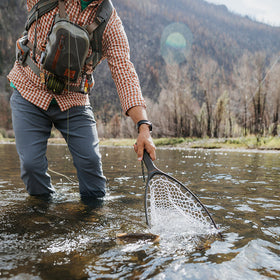
Famous Fly History: Elk Hair Caddis

Capable of being tied in many variations and alongside its versatility and durability, the Elk Hair Caddis is a go to for anglers across the world and is a staple in any fly box.
Fly fishing has long been a sport that involves tradition, and the passing of knowledge and information from one generation to the next. These pieces of knowledge usually involve techniques, locations, philosophies and the like. However, of all the things passed down from one fly fisherman to the next; perhaps the most important and varied of them all are fly patterns and how to tie them. Whether you are the newest rookie fly fisherman out there, or the most advanced, hardcore angler in existence, all of us use flies to catch fish. The origins of these flies are often overlooked by the average angler, despite having rich histories worth learning about. One of these flies is the Elk Hair Caddis.

If you haven't heard of the Elk Hair Caddis, then well, you may have been living under a rock for the duration of your fly fishing career. All jokes aside, this pattern is arguably one of the most well known, and popular flies out there and for good reason. Capable of being tied in many variations and alongside its versatility and durability, the Elk Hair Caddis is a go to for anglers across the world and is a staple in any fly box.

Invented by fly fishing legend Al Troth in 1957, the Elk Hair Caddis was originally designed to imitate adult insects during the Green Caddis Hatch. Troth was born and raised in Pennsylvania, where he started fishing at the age of twelve. It quickly became a lifelong pursuit for him, and throughout his life he developed as both an angler and fly tier. Troth had numerous professions, including a four year stint in the Navy as well as a 15 year career as a high school teacher. His passion for fly fishing however led him across the United States, and he took many trips to Montana where he eventually moved despite living on the east coast for many years. He invented numerous fly patterns and was featured in many books and magazines as a result; including three appearances on the cover of Fly Fisherman Magazine.

In an article published in 1978 for Fly Tyer Magazine, Troth mentions that with the Elk Hair Caddis, he was originally attempting to create a wet fly to imitate green caddisflies in his local Pennsylvania Streams. The fly floated so well however, that he embraced it as a dry fly pattern and fished it as such. Tying the original pattern was actually relatively simple. Troth started with a body involving fine copper wire, dubbing and rooster hackle. He then created a wing with bleached hair from a female elk in order to make the filaments more visible. This recipe withstood the test of time, and the fly is still tied in this fashion today.
There is no wrong way to fish the Elk Hair Caddis. Though it is traditionally fished as a dead-drifted dry fly, it can also be skated, or stripped through the surface film to imitate an emerger. It can even be fished as a wet fly, either swung or under an indicator, though these methods are less common. The fly can be tied in almost any size, with smaller sizes (#12-#20) imitating caddisflies or small stoneflies; and with larger sizes (#2-#10) imitating larger terrestrials, moths, and even the prolific Salmonfly.

Next time you’re on the river, examining your box of flies, take time to understand that each of them has a history. Part of the beauty of our sport is the timeless passing down of knowledge and tradition, so remember to appreciate our fly fishing ancestors. Oh, and next time you find yourself in the middle of a caddis hatch, bust out that Elk Hair Caddis and say a quiet thank you to the man Al Troth. A true fly fishing legend. Tight lines everyone!





Leave a comment